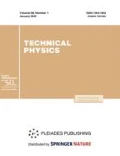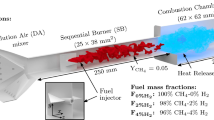Abstract
The results of an experimental study of the relationship between the width of the turbulent combustion zone (TCZ) and the composition of the composite fuel (hythane), the maximum pressure in the combustion chamber of variable volume, and the propagation speed and electrical conductivity of the turbulent flame are presented. It was found that the width of the TCZ has a characteristic dependence on the composition of hythane. It was experimentally found that, despite the change in the coefficient of excess of air, the hydrogen concentration in the fuel, the turbulence intensity and type of fuel (hythane and gasoline), and the dependences of the TCZ width on the turbulent flame propagation velocity and on the electrical conductivity of the flame remain unchanged, as well as the dependence of the maximum pressure on the width of the TCZ. The results of the work can be used in the design and development of energy-efficient and low-emission combustion chambers.




Similar content being viewed by others
REFERENCES
T. Sandalci, S. Galata, and Y. Karagoz, Int. J. Hydrogen Energy, No. 5, 3208 (2019).
S. Tangoz and N. Kahraman, Int. J. Hydrogen Energy, No. 5, 25766 (2017).
A. Mariani, A Review of Hydrogen-Natural Gas Blend Fuels in Internal Combustion Engines (InTech Europe, 2012).
F. Ma, Hydrogen-Enriched Compressed Natural Gas as a Fuel for Engines, Natural Gas (InTech Europe, 2010).
G. Verma, R. K. Prasad, and R. A. Agarwal, Fuel, No. 178, 209 (2016).
A. P. Shaikin and I. R. Galiev, Russ. Aeronaut. 59, 249 (2016).
A. P. Shaikin and I. R. Galiev, Tech. Phys. 61 (8), 1206 (2016).
A. D. Deryachev, Empirical Model for Estimating the Concentration of Nitrogen Oxides with Addition of Hydrogen in the Fuel Assembly of Spark-Ignition Engines (Tolyatti, 2015) [in Russian].
R. T. Hermanns, Laminar Burning Velocities of Methane-Hydrogen-Air Mixtures (Tech. Univ. Eindhoven, Eindhoven, 2007).
A. N. Lipatnikov and J. Chomiak, Prog. Energy Combust. Sci., No. 28, 1 (2002).
N. Peters, Combustion Theory (Princeton, 2010).
Funding
This work was published with the support of the Ministry of Science and Higher Education of the Russian Federation in the framework of the Program of Granting a Scholarship of the President of the Russian Federation for Young Scientists SP-3204.2018.1.
Author information
Authors and Affiliations
Corresponding author
Ethics declarations
The authors declare that they have no conflicts of interest.
Additional information
Translated by V. Selikhanovich
Rights and permissions
About this article
Cite this article
Shaikin, A.P., Galiev, I.R. On the Relationship of the Width of the Turbulent Combustion Zone with the Fuel Composition, Pressure, Propagation Speed, and Electrical Conductivity of the Flame. Tech. Phys. 65, 1020–1023 (2020). https://doi.org/10.1134/S106378422007018X
Received:
Revised:
Accepted:
Published:
Issue Date:
DOI: https://doi.org/10.1134/S106378422007018X




